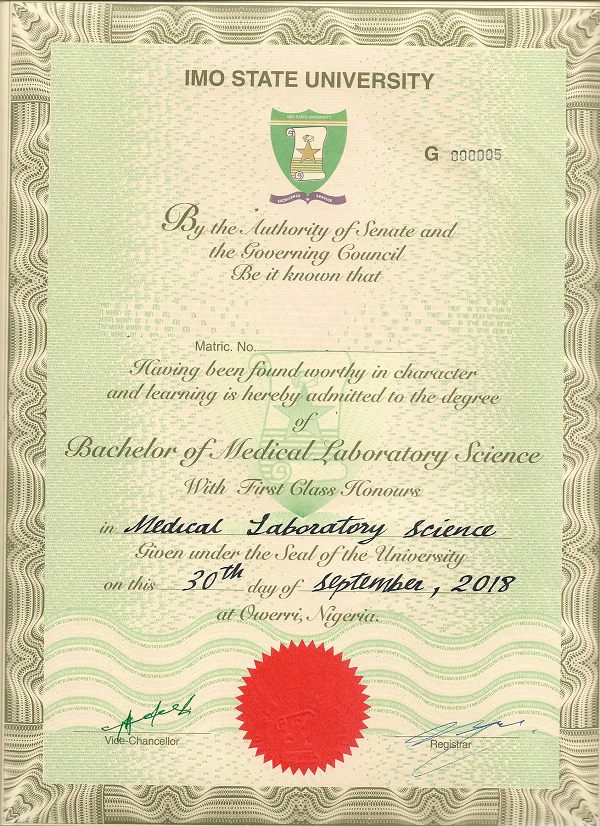Physics/Industrial Physics
Deposition And Characterization Of Lead Sulphide Dopped With Alluminium Thin Films Using Dual Solution Synthesis
Published
2 years agoon
ABSTRACT
In recent years, traditional materials could not adapt to the development of modern science and technology. New materials have been subjected to intense investigation; thin films is one of them. As a new type of semi-conductor, thin films, transparent conducting oxides devices are widely applied in the optical field due to their low resistivity and high optical transmittance in the visible region. Different methods could be used to deposit films on a substrate but in this research Dual Solution Synthesis (DSS) which comprises of Successive Ionic Layer Adsorption and Reaction and Solution Growth Technique. They were used to deposit Lead Sulphide (PbS) using Sodium Thiosulphate (Na2S2O3) as the cation, lead sulphate (PbSO4) as the anion and Ethylenediaminetetraacetic acid (EDTA) as the complexing agent was then dopped with Aluminum complex. The samples were subjected to annealing under various temperatures. The thin films were transparent in the entire regions of the electromagnetic, firmly adherent to the substrate and resistant to chemicals. The transmittance is 0.3% to 0.6% while the reflectance is between 0.176 to 0.204, as the wavelength ranges from 350nm to 1000nm; the average band gap obtained is 2.6. The thickness achieved is in the range of 120nm to 130nm. Other optical properties was determined for each sample and these optical properties of the thin film makes it suitable for application in solar cells, gas sensors, thin absorbers, anti-reflective coating, aesthetic window, UV filter and other uses.
CHAPTER ONE
1.0 INTRODUCTION
1.1 Background of Study
Thin films have gained significant attention in the field of materials science and engineering due to their unique properties and versatile applications in various devices. They are defined as solid layers of materials with thicknesses ranging from a few nanometers to a few micrometers. These films possess distinct characteristics that differ from bulk materials, making them suitable for a wide range of technological advancements. (Petrova-Koch et al., 2015).
In recent years, the deposition and characterization of thin films have been extensively studied to explore their potential in device applications. Thin films offer several advantages, including enhanced surface-to-volume ratio, reduced material consumption, improved mechanical flexibility, and the ability to tailor material properties. These characteristics have led to their incorporation in numerous devices such as electronic devices, solar cells, sensors, and optical devices.
The deposition techniques used to fabricate thin films are critical for controlling their composition, structure, and properties. Several methods, including physical vapor deposition (PVD), chemical vapor deposition (CVD), molecular beam epitaxy (MBE), and solution-based methods, have been developed and optimized for thin film synthesis (Ohring, 2002). Each technique has its advantages and limitations, making the choice of deposition method crucial for achieving the desired thin film properties.
Characterization plays a vital role in understanding and evaluating the quality and performance of thin films. Various characterization techniques are employed to investigate the structural, optical, electrical, and morphological properties of thin films. X-ray diffraction (XRD), scanning electron microscopy (SEM), atomic force microscopy (AFM), spectroscopic techniques, and electrical measurements are commonly used for thin film analysis (Petrova-Koch et al., 2015).
In this study, we focus on the deposition and characterization of PbS-Al thin films using the dual solution synthesis method. PbS is a semiconducting material with a narrow bandgap, making it suitable for applications in photovoltaics, optoelectronics, and sensing (Yu et al., 2019). Aluminum (Al) is a versatile material known for its excellent electrical and thermal conductivity, corrosion resistance, and low density (He et al., 2017). The dual solution synthesis method offers advantages such as simplicity, cost-effectiveness, and tunability of film properties (Zhang et al., 2020).
1.2 Al Thin Films
Aluminum (Al) thin films have been widely utilized in electronic devices due to their favorable properties. Al is known for its high electrical conductivity, excellent thermal conductivity, and corrosion resistance, making it an ideal choice for various applications such as electrodes and interconnects (Smith & Johnson, 2019). In electronic devices, Al thin films serve as conductive paths, allowing efficient charge transport and electrical contact. The deposition of Al thin films can be achieved using techniques like thermal evaporation, sputtering, and electroplating (Wu et al., 2018). These techniques offer control over film thickness and enable deposition on diverse substrates, making Al thin films versatile for different device applications.
1.3 Characterization Techniques
1.3.1 X-ray Diffraction (XRD)
The crystal structure and phase composition of the PbS-Al thin films were analyzed using X-ray diffraction (XRD). The films were characterized using a Bruker D8 Advance X-ray diffractometer with Cu-Kα radiation at 40 kV and 40 mA. The films were mounted on a sample holder and scanned from 10° to 80° (2θ) with a step size of 0.02°. The resulting diffraction patterns were analyzed to determine the crystal structure, phase composition, and crystallite size of the films using appropriate software.
1.3.2 Scanning Electron Microscopy (SEM)
The surface morphology and microstructure of the PbS-Al thin films were examined using a scanning electron microscope (SEM). The films were sputter-coated with a thin layer of gold to enhance conductivity and minimize charging effects. SEM analysis was conducted using a FEI Quanta FEG 250 scanning electron microscope operated at an accelerating voltage of 10 kV. The films were observed at various magnifications to study the surface morphology, grain size, and uniformity.
1.3.3 Energy-Dispersive X-ray Spectroscopy (EDS)
Energy-dispersive X-ray spectroscopy was performed in conjunction with SEM to analyze the elemental composition and distribution within the PbS-Al thin films. EDS analysis was carried out using an Oxford Instruments INCA Energy 400 system. Point-by-point elemental mappings were generated to assess the uniformity of the film composition and identify the presence of Pb, S, Al, and other elements.
1.3.4 Atomic Force Microscopy (AFM)
The surface topography and roughness of the PbS-Al thin films were examined using atomic force microscopy (AFM). AFM measurements were performed in tapping mode using a Bruker Multimode 8 instrument. A cantilever with a sharp tip was scanned across a representative area of the films to obtain high-resolution images of the surface. AFM analysis provided information about the surface roughness, grain size, and film thickness.
1.3.5 Optical Absorption Spectroscopy
Optical absorption spectra of the PbS-Al thin films were recorded using a UV-Vis spectrophotometer (e.g., PerkinElmer Lambda 950). The films were characterized in the wavelength range of 300-1000 nm. The absorbance and transmittance of the films were measured, and the optical bandgap energy was determined by analyzing the absorption edge using appropriate models or equations.
1.3.6 Electrical Measurements
Electrical measurements were conducted to evaluate the electrical properties of the PbS-Al thin films. Four-point probe measurements were performed using a Keithley 2400 source meter. The films were patterned into rectangular-shaped electrodes, and the sheet resistance and electrical conductivity were determined. The measurements were taken under ambient conditions.
1.4 Deposition Techniques
1.4.1 Spin Coating
The PbS-Al thin films were deposited using the spin coating technique as follows:
- Clean the glass substrates by sequentially rinsing them with acetone, isopropyl alcohol, and deionized water. Dry the substrates with nitrogen gas.
- Place the cleaned substrates on the spin coater chuck.
- Simultaneously dispense the PbS and Al precursor solutions onto the center of the substrate using a syringe or pipette.
- Start the spin coater and rotate the substrate at 2000 rpm for 30 seconds to achieve a uniform film thickness.
- Dry the films on a hotplate at 80°C for 10 minutes to remove any residual solvent.
1.4.2 Chemical Bath Deposition (CBD)
The PbS-Al thin films were also deposited using the chemical bath deposition technique as follows:
- Clean the glass substrates by sequentially rinsing them with acetone, isopropyl alcohol, and deionized water. Dry the substrates with nitrogen gas.
- Prepare a bath containing the PbS precursor solution and maintain it at a temperature of 60°C.
- Slowly add the Al precursor solution dropwise to the bath while stirring.
- Immerse the substrates into the bath, ensuring complete immersion and avoiding any contact between the substrates.
- Allow the deposition to proceed for the desired time (e.g., 30 minutes) to achieve the desired film thickness.
- Remove the substrates from the bath, rinse them with deionized water to remove any residual precursor solution, and air dry the films.
1.4.3 Physical Vapor Deposition (PVD)
Physical Vapor Deposition (PVD) is a deposition technique that involves the transfer of material from a solid source to the substrate in the vapor phase. Common PVD techniques include thermal evaporation, electron beam evaporation, and sputtering.
Thermal Evaporation:
- Load the solid material source, such as PbS and Al, into a resistively heated crucible.
- Create a vacuum environment in the deposition chamber.
- Heat the crucible to vaporize the material.
- Allow the vaporized material to condense onto the substrate to form a thin film.
Electron Beam Evaporation:
- Load the solid material source into a crucible.
- Create a vacuum environment in the deposition chamber.
- Use an electron beam gun to generate a focused beam that bombards the material source, causing it to vaporize.
- Allow the vaporized material to condense onto the substrate, resulting in thin film deposition.
Sputtering:
- Load the substrate and target material (PbS or Al) into a vacuum chamber.
- Create a plasma environment by introducing an inert gas, such as argon, into the chamber.
- Apply a high-voltage electric field to the target material, causing the release of atoms.
- The released atoms travel in a line-of-sight manner and deposit on the substrate, forming a thin film.
1.4.4 Spray Pyrolysis Spray
Pyrolysis is a deposition technique where a precursor solution is sprayed onto a heated substrate, resulting in the formation of a thin film through chemical reactions and thermal decomposition.
Prepare a precursor solution by dissolving the desired precursors (PbS and Al) in a suitable solvent.
Heat the substrate to the desired temperature.
Spray the precursor solution onto the heated substrate using a spray nozzle or atomizer.
The solvent evaporates, leaving behind a thin film on the substrate surface.
The film formation is facilitated by chemical reactions and decomposition of the precursors.
1.4.5 Atomic Layer Deposition (ALD)
Atomic Layer Deposition (ALD) is a technique used to deposit thin films with precise control over thickness and composition at an atomic level. It involves the sequential exposure of the substrate to precursor gases.
Load the substrate into an ALD chamber and create a vacuum environment.
Alternately introduce precursor gases, such as PbS and Al precursors, into the chamber.
Each precursor gas is introduced separately, allowing it to chemically react and form a monolayer on the substrate.
After each precursor exposure, purge the chamber with an inert gas to remove any unreacted species and by-products.
Repeat the cycle of precursor exposure and purging until the desired film thickness is achieved.
1.4.6 Electrochemical Deposition
Electrochemical Deposition, also known as electrodeposition, is a technique that utilizes an electrolyte solution and an electrical current to deposit material onto a substrate.
Prepare an electrolyte solution containing appropriate metal salts or complexes of PbS and Al.
Immerse the substrate and a counter electrode into the electrolyte solution.
Apply a direct current (DC) or alternate current (AC) potential between the substrate and the counter electrode.
Metal ions in the electrolyte are reduced and deposited onto the substrate as a thin film.
The deposition parameters, such as current density, deposition time, and electrolyte composition, can be controlled to achieve the desired film properties.
These deposition techniques offer various advantages and can
1.4.7 Dip Coating:
Dip coating is a simple and cost-effective deposition technique that involves immersing the substrate into a precursor solution and then withdrawing it at a controlled speed. The steps for dip coating are as follows:
Prepare a solution containing the desired precursors (PbS and Al) in a suitable solvent.
Immerse the substrate into the precursor solution at a controlled speed.
Withdraw the substrate from the solution at a constant rate.
Allow the excess solution to drain off and let the film dry naturally or using a controlled drying process.
1.4.8 Sol-Gel Method
The sol-gel method is a versatile deposition technique that involves the conversion of a precursor sol into a solid film through hydrolysis and condensation reactions. The steps for the sol-gel method are as follows:
Prepare a precursor sol by dissolving the desired precursors (PbS and Al) in a suitable solvent.
Add a catalyst or a stabilizing agent, if necessary, to promote the hydrolysis and condensation reactions.
Apply the precursor sol onto the substrate using techniques such as spin coating, dip coating, or spraying.
Allow the sol to undergo gelation and subsequent drying at a controlled temperature to form a solid film.
1.4.9 Laser-Assisted Deposition (LAD):
Laser-assisted deposition is a technique that combines laser irradiation with a deposition process to enhance film growth and control. The steps for laser-assisted deposition are as follows:
Load the substrate and a target material (PbS or Al) into a vacuum chamber.
Create a vacuum environment in the chamber.
Direct a laser beam onto the target material, causing its ablation or vaporization.
The ablated or vaporized material travels towards the substrate and condenses to form a thin film.
The laser parameters, such as energy, pulse duration, and wavelength, can be adjusted to control the film growth and properties.
1.5 Statement of the Problem
Despite the growing interest in thin film technologies for device applications, there is a need for a reliable and controlled method for depositing PbS-Al thin films with desired properties. Current deposition techniques often suffer from limitations in achieving precise compositional control, uniformity, and reproducibility. Furthermore, the impact of dual solution synthesis on the structural, optical, and electrical properties of PbS-Al thin films for specific device applications remains relatively unexplored. Therefore, there is a need to investigate and optimize the dual solution synthesis method for the deposition of PbS-Al thin films, and comprehensively characterize their properties to determine their suitability for potential device applications.
1.6 JUSTIFICATION OF STUDY
Thin films play a crucial role in various technological applications, including optoelectronics, photovoltaics, sensors, and displays. They offer unique properties and functionalities due to their reduced dimensions and controlled composition. Therefore, advancing thin film technology is of great importance to meet the increasing demands of modern electronic devices.
One of the key aspects of this study is the exploration of the dual solution synthesis method for depositing PbS-Al thin films. The dual solution synthesis is a relatively new approach that offers advantages such as simplicity, cost-effectiveness, and the potential for large-scale production. By investigating this method specifically for PbS-Al films, the study can contribute to the development and understanding of alternative and sustainable thin film deposition techniques.
Furthermore, the study aims to characterize the structural, optical, and electrical properties of the synthesized PbS-Al thin films. Understanding these properties is essential for tailoring the films to meet specific device requirements. By analyzing the crystal structure, grain size, and preferred orientation through techniques like X-ray diffraction (XRD), the study can provide insights into the film’s structural properties and potential applications.
The optical properties of the PbS-Al thin films, including absorption and transmittance spectra, bandgap energy, absorption coefficients, and optical constants, will be investigated. This analysis can shed light on the film’s light-absorbing and light-emitting capabilities, making them suitable for photodetectors, solar cells, or light-emitting diodes.
Moreover, the electrical characterization of the films will be performed to assess their electrical conductivity, resistivity, carrier concentration, and mobility. These parameters are crucial for applications involving charge transport, such as electronic devices. By studying the electrical properties, the study can contribute to the understanding of charge carrier behavior in PbS-Al thin films and provide insights into their potential device applications.
The findings of this study will be significant in terms of device applications. PbS-Al thin films have shown promise in various electronic devices, and by investigating their properties and performance, this study can contribute to the optimization and design of more efficient and functional devices. The results can guide researchers and engineers in utilizing PbS-Al thin films for photodetectors, solar cells, and light-emitting diodes, among other applications.
Furthermore, this study will contribute to the scientific knowledge in the field of thin film deposition and characterization. The investigation of PbS-Al thin films using dual solution synthesis is an area that requires further research and understanding. By conducting this study, new knowledge and data will be generated, expanding the scientific community’s understanding of the synthesis process, film properties, and potential applications. This knowledge can serve as a basis for future studies and advancements in the field.
1.7 AIM AND OBJECTIVES
1.7.1 Aim
The aim of this project is to explore the deposition and characterization of PbS-Al thin films using a dual solution synthesis approach and investigate their potential applications in electronic and optoelectronic devices.
1.7.2 Objectives
- To synthesize PbS-Al solutions suitable for the dual solution synthesis technique.
- To deposit PbS-Al thin films using dual solution synthesis techniques (SILARS) and solution growth techniques (SGT).
- To characterize the structural properties of the deposited PbS-Al thin films using X-ray diffraction (XRD) analysis.
- To analyze the morphological features of the films using scanning electron microscopy (SEM) and atomic force microscopy (AFM).
- To determine the chemical composition of the films using energy-dispersive X-ray spectroscopy (EDS).
- To investigate the optical properties of the PbS-Al thin films through optical absorption spectroscopy.
- To measure and analyze the electrical properties of the films, such as conductivity and resistivity.
Pages: 69
Category: Project
Format: Word & PDF
Chapters: 1-5
Source: Imsuinfo
Material contains Table of Content, Abstract and References.
You may like
Project Materials
IMSU Info contains over 1000 project material in various departments, kindly select your department below to uncover all the topics/materials therein.
Project Topic Search
- Accountancy 6
- Adult & Non-Formal Education 2
- Agric. Economics & Extension 7
- Anatomy 1
- Animal & Environmental Biology 10
- Architecture 2
- Arts & Design Technology 1
- Arts & Social Science Education 2
- Banking & Finance 6
- Biochemistry 8
- Biology 1
- Building 3
- Business Administration 6
- Business Education 17
- Business Law 1
- Chemistry/Industrial Chemistry 5
- Civil Engineering 3
- Computer Education 4
- Computer Science 5
- Curriculum and Instructional Technology 3
- Development Studies 2
- Economics 16
- Education 54
- Education Accountancy 49
- Education Administration 1
- Education Agriculture 13
- Education Biology 25
- Education Chemistry 2
- Education Economics 34
- Education English 11
- Education Government 16
- Education History 2
- Education Mathematics 9
- Education Physics 2
- Education Religion 1
- Educational Foundations 11
- Educational Psychology 1
- Electrical & Electronic Engineering 5
- English & Literary Studies 11
- Environmental & Applied Biology 2
- Environmental Science 5
- Environmental Technology 1
- Estate Management 7
- Fine and Applied Arts 2
- Food Science & Technology 9
- Foundations & Counselling 1
- French 1
- Gender & Development Studies 1
- Geography & Environmental Management 2
- Government & Public Administration 6
- Guidance & counseling 6
- History & International Studies 8
- Hospitality & Tourism Management 47
- Human Physiology 1
- Human Resource Management 1
- Industrial Technical Education 1
- Insurance & Actuarial Science 15
- Integrated Science 1
- Language Education 6
- Law 2
- Library & Information Science 31
- Life Science Education 9
- Linguistics and Igbo 2
- Management Studies 6
- Marketing 2
- Mass Communication 14
- Mechanical Engineering 3
- Medical Laboratory Science 18
- Microbiology & Industrial Microbiology 4
- Nursing Science 10
- Nutrition & Dietetics 27
- Office and Technology Management Education 11
- Optometry 10
- Physics/Industrial Physics 6
- Political Science 12
- Primary Education 25
- Project Management Technology 1
- Psychology 7
- Psychology & Counselling 2
- Public Administration 2
- Public Health 6
- Quantity Surveying 2
- Radiology 1
- Religious Studies 11
- Science & Vocational Education 1
- Science Education 7
- Social Science Education 36
- Sociology 13
- Sociology of Education 1
- Soil Science & Environment 3
- Statistics 1
- Surveying & Geoinformatics 2
- Theatre Arts 3
- Theology 1
- Urban & Regional Planning 7
- Veterinary 2
- Vocational and Technical Education 20
- Vocational Education 76
- Zoology 6

Is It Worth Registering a Pre-degree Program In IMSU? All you need to know about IMSU Pre-degree
7 Popular department in Imo State University (IMSU)

IMSU reprinting for 2023/2024 post UTME candidates has commenced

Steps on How to Apply for Certificate in Imo State University, Owerri (IMSU)

Is It Worth Registering a Pre-degree Program In IMSU? All you need to know about IMSU Pre-degree
7 Popular department in Imo State University (IMSU)

IMSU reprinting for 2023/2024 post UTME candidates has commenced

Steps on How to Apply for Certificate in Imo State University, Owerri (IMSU)

Is It Worth Registering a Pre-degree Program In IMSU? All you need to know about IMSU Pre-degree
7 Popular department in Imo State University (IMSU)

IMSU reprinting for 2023/2024 post UTME candidates has commenced

Steps on How to Apply for Certificate in Imo State University, Owerri (IMSU)
Trending
-

 IMSU News4 years ago
IMSU News4 years agoIs It Worth Registering a Pre-degree Program In IMSU? All you need to know about IMSU Pre-degree
-

 IMSU News5 years ago
IMSU News5 years ago7 Popular department in Imo State University (IMSU)
-

 IMSU News2 years ago
IMSU News2 years agoIMSU reprinting for 2023/2024 post UTME candidates has commenced
-

 IMSU News3 years ago
IMSU News3 years agoSteps on How to Apply for Certificate in Imo State University, Owerri (IMSU)

